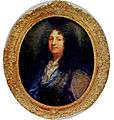Jean-Baptiste Santerre
| Jean-Baptiste Santerre | |
|---|---|
 Self-portrait of Santerre. | |
| Born |
Santerre 23 March 1651 Magny-en-Vexin |
| Died |
21 November 1717 Paris |
| Nationality | French |
| Known for | painting |
| Movement | classicism |
Jean-Baptiste Santerre (23 March 1651 – November 21, 1717), was a French painter often associated with Jean-Honoré Fragonard but notable in his own right.[1]
Biography
Santerre was born at Magny-en-Vexin, near Pontoise. A pupil of Bon Boullogne, he began his painting career at a portraitist, with a notable work being a portrait of Marie Leszczyńska with the Maison de St Cyr in the background (now at the musée de Versailles). He won a major reputation thanks to his academies. His most notable work[2] is his Susanna Bathing (Louvre), the diploma work executed by him in 1704, when he was received into the Académie (though the version now in the Louvre seems to be a copy by Santerre of the original). Although his religious paintings lacked inspiration, the Susanna contributed to Santerre's fifty-year reputation as a painter of the erotic nude, in which field he was the forerunner to François Boucher (1730–1770) and Jean-Honoré Fragonard (1732–1806). The Susanna and his Portrait of a Lady in Venetian Costume (Louvre) give a good impression of Santerre's taste and of his elaborate, refined and careful method. He died at Paris.
Paintings
.jpg) Susanna Bathing
Susanna Bathing_par_Santerre.jpg) Philippe d'Orleans, regent, and Marie Madeleine de la Vieuville, Comtesse de Parabère (1693-1755)
Philippe d'Orleans, regent, and Marie Madeleine de la Vieuville, Comtesse de Parabère (1693-1755) Jean Racine
Jean Racine
- Woman Pulling a Curtain, Paris, Galerie Eric Coatalem
- Two Actresses, St Petersburg, Hermitage Museum
- Susanna Bathing, Louvre
- Portrait of a lady in Venetian costume, known as the Marquise de Moulins-Rochefort Louvre
- Young woman writing a letter, Valenciennes, Musée des Beaux-Arts

- Jean-Baptiste Santerre (1651–1717) (self-portrait), Versailles, Musée National du Château et des Trianons
- Marie-Adelaide de Savoie, duchesse de Bourgogne (1685–1712), Versailles, Musée National du Château et des Trianons
- Philippe d'Orleans, regent, et Marie Madeleine de la Vieuville, Comtesse de Parabère (1693–1755), Versailles, Musée National du Château et des Trianons
- Saint Theresa in ecstasy, Versailles, Musée National du Château et des Trianons
- The cook, Le Mans, Musée de Tessé
- Portrait of Nicolas Boileau, Musée des beaux-arts de Lyon
- Young smoker, Musée des beaux-arts de Chambéry
- Mlle. Desmares
- Jean Racine
- Young Woman Wearing a Shawl
- The comtesse de Bersac
Bibliography
| Wikimedia Commons has media related to Jean-Baptiste Santerre. |
- Full catalogue of his works - (French) Claude Lesné: Jean-Baptiste Santerre, 1651-1717, in the bulletin of the Société de l'histoire de l'art français, 1988.
References
- ↑ "H-France Review Vol. 14 (July 2014), No. 120" (PDF).
- ↑
 Chisholm, Hugh, ed. (1911). "Santerre, Jean Baptiste". Encyclopædia Britannica (11th ed.). Cambridge University Press.
Chisholm, Hugh, ed. (1911). "Santerre, Jean Baptiste". Encyclopædia Britannica (11th ed.). Cambridge University Press.